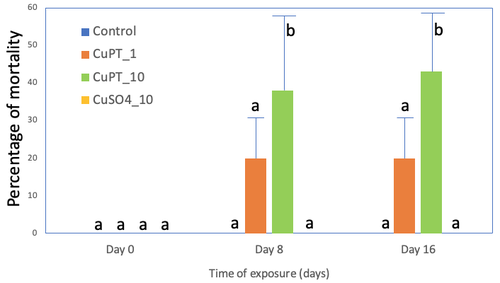
VOISIN Anne-Sophie
- Swiss Centre for Applied Ecotoxicology, Swiss Centre for Applied Ecotoxicology, Dübendorf, Switzerland
- Aquatic ecotoxicology, Bioassays, Biomarkers, Biomonitoring, Genetics / Genomics
Recommendations: 0
Review: 1
Review: 1

Characterization of the bioaccumulation and toxicity of copper pyrithione, an antifouling compound, on juveniles of rainbow trout
Bioaccumulation and impact of copper pyrithione impact in juveniles of rainbow trout
Recommended by Claudia Cosio based on reviews by Anne-Sophie Voisin and 1 anonymous reviewerOur ability to anticipate and estimate how pollution affects biota is intrumental in the field of ecotoxicology. Impact of chemical pollution by metals, drugs or pesticides was widely studied in different species using acute and chronic scenarios. Since the ban on tributyltin in antifouling paints, other copper (Cu)-based paints are on the market, including a new generation of booster biocides:metal pyrithiones such as Cu pyrithione (CuPT). Pyrithione acts as a Cu ionophore facilitating Cu transport across the membranes. Although some data show their occurrence in aquatic ecosystems and few studies on the toxicity of CuPT in fish are published, major gaps in knowledge remain about their toxicity and toxic pathway. Few studies were previously conducted in animals exposed to CuPT pointing to reprotoxicity, developmental malformation and mortality (Li et al. 2021, Mochida et al., 2011; Mohamat-Yusuff et al., 2018, Shin et al., 2022). However, its toxicokinetic and toxicodynamic remain to be characterized in details.
In this context, Bourdon et al. (2023) compared in juveniles of rainbow trout (Oncorhynchus mykiss), the effects of exposure to CuPT and ionic Cu2+ at equivalent Cu2+ molar concentrations. Presented data allow to compare the toxicity threshold, the accumulation of Cu and mechanisms of toxicity of both compounds. Acute and chronic exposures showed a higher bioaccumulation of Cu in the gills, and a higher toxicity of CuPT than that of ionic Cu2+, e.g. mortality , transcription levels of genes related to oxidative stress, detoxification and Cu transport. Intriguingly, the activities of enzymatic biomarkers used as proxy of antioxidant capacity were not significantly altered, although Cu is generally expected to trigger oxidative stress. In conlusion, this study brings new knowledge pointing that the presence of CuPT in the environment could induce toxic effects in non-target species. Moreover, it support the need to study in detail the toxicity of Cu-based paints to adapt regulations concerning their use and release in aquatic environments. Because of its low solubility in water, CuPT is expected to adsorb to suspended matter and food pellets. Future research should study this route of exposure.
References
Bourdon, C., Cachot, J., Gonzalez, P., Couture, P., 2023. Characterization of the bioaccumulation and toxicity of copper pyrithione, an antifouling compound, on juveniles of rainbow trout, bioRxiv ver. 3 peer-reviewed and recommended by Peer Community in Ecotoxicology and Environmental Chemistry. https://doi.org/10.1101/2023.01.31.526498
Li, X., S. Ru, H. Tian, S. Zhang, Z. Lin, M. Gao and J. Wang, 2021. Combined exposure to environmentally relevant copper and 2,2′-dithiobis-pyridine induces significant reproductive toxicity in male guppy (Poecilia reticulata). Science of the Total Environment 797, https://doi.org/10.1016/j.scitotenv.2021.149131
Mochida, K., Amano, H., Onduka, T., Kakuno, A., Fujii, K., 2011. Toxicity and metabolism of copper pyrithione and its degradation product, 2,2’-dipyridyldisulfide in a marine polychaete. Chemosphere 82, 390–397, https://doi.org/10.1016/j.chemosphere.2010.09.074
Mohamat-Yusuff, F., Sarah-Nabila, Ab.G., Zulkifli, S.Z., Azmai, M.N.A., Ibrahim, W.N.W., Yusof, S., Ismail, A., 2018. Acute toxicity test of copper pyrithione on Javanese medaka and the behavioural stress symptoms. Marine Pollution Bulletin 127, 150–153, https://doi.org/10.1016/j.marpolbul.2017.11.046
Shin, D., Y. Choi, Z. Y. Soon, M. Kim, D. J. Kim and J. H. Jung, 2022. Comparative toxicity study of waterborne two booster biocides (CuPT and ZnPT) on embryonic flounder (Paralichthys olivaceus). Ecotoxicology and Environmental Safety 233, https://doi.org/10.1016/j.ecoenv.2022.113337